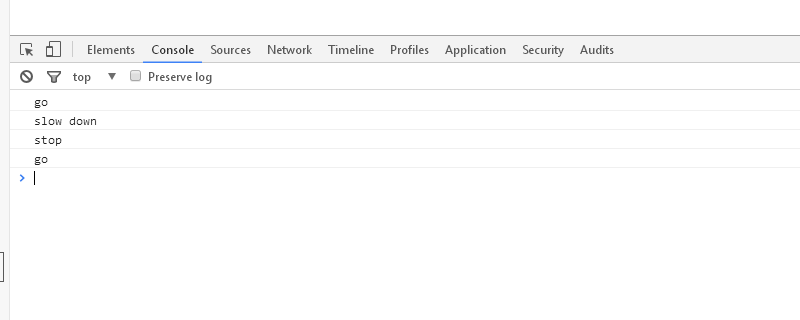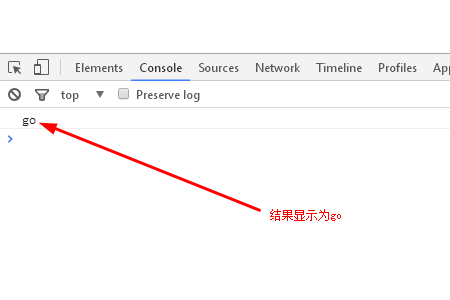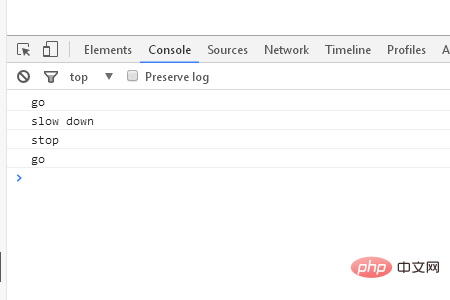How to use methods in JavaScript
Methods are functions assigned to object properties. When a function is defined in an object's properties, it is called a method of the object rather than a function. This article will introduce you to methods in How to use methods in How to use methods in How to use methods in JavaScript. use.

Attributes are pre-set specific information (values) to which a name (attribute name) is added. In its properties, the function is specifically called a "method".
Let’s look at a specific example
In the following program, we create an object based on the traffic light blue, yellow, red and put it In a variable called traffic_light.
<!DOCTYPE html>
<html>
<head>
<meta charset = "utf-8">
<title>How to use methods in How to use methods in How to use methods in JavaScript</title>
</head>
<body>
<script>
var traffic_light = {
blue: "go",
yellow: "slow down",
red: "stop"
}
</script>
</body>
</html>We added a property called current here. Contains the color of the traffic light in current.
<script>
var traffic_light = {
blue: "go",
yellow: "slow down",
red: "stop", current: " "
}
</script>The function that changes the color of the traffic light is defined as change_light. Then, change the value of this current by calling a method (function) called change_light.
We first define the function change_light
Continue to use function in the above program, let us temporarily define the function as change_light.
Let's consider the next signal calling change_light to determine the behavior of the next property to be called, depending on what is current at that time.
Use the switch statement to set change_light to four modes.
If the attribute contained in current is blue, the next attribute will be changed to yellow.
If the attribute contained in current is yellow, the next attribute will be changed to red.
If the attribute contained in current is red, the next attribute will be changed to blue.
The default is blue.
<script>
var traffic_light = {
blue: "go",
yellow: "slow down",
red: "stop",
current: " "
}
function change_light(){
switch(traffic_light.current){
case traffic_light.blue:
traffic_light.current = traffic_light.yellow;
break;
case traffic_light.yellow:
traffic_light.current = traffic_light.red;
break;
case traffic_light.red:
traffic_light.current = traffic_light.blue;
break;
default:
traffic_light.current = traffic_light.blue;
break
}
}
</script>Next, check the results by calling current in console.log
<script>
var traffic_light = {
blue: "go",
yellow: "slow down",
red: "stop",
current: " "
}
function change_light(){
switch(traffic_light.current){
case traffic_light.blue:
traffic_light.current = traffic_light.yellow;
break;
case traffic_light.yellow:
traffic_light.current = traffic_light.red;
break;
case traffic_light.red:
traffic_light.current = traffic_light.blue;
break;
default:
traffic_light.current = traffic_light.blue;
break
}
} change_light();
console.log(traffic_light.current);
</script>Because the default attribute is set to blue, the value of blue is output as go.

Use console.log to repeat the call three times...
<script>
var traffic_light = {
blue: "go",
yellow: "slow down",
red: "stop",
current: " "
}
function change_light(){
switch(traffic_light.current){
case traffic_light.blue:
traffic_light.current = traffic_light.yellow;
break;
case traffic_light.yellow:
traffic_light.current = traffic_light.red;
break;
case traffic_light.red:
traffic_light.current = traffic_light.blue;
break;
default:
traffic_light.current = traffic_light.blue;
break
}
}
change_light();
console.log(traffic_light.current);
change_light();
console.log(traffic_light.current);
change_light();
console.log(traffic_light.current);
change_light();
console.log(traffic_light.current);
</script>current changes from blue->yellow->red-> The output of the blue
value is go->slow down->stop->go

change_light as traffic_light
What to do is to set the attribute name change_light after current: "" and use the following function to separate it (such as with ":" separate them). (At this point, the consecutive function name change_light is duplicated, so it can be deleted)<script>
var traffic_light = {
blue: "go",
yellow: "slow down",
red: "stop",
current: " ",
change_light:function(){
switch(traffic_light.current){
case traffic_light.blue:
traffic_light.current = traffic_light.yellow;
break;
case traffic_light.yellow:
traffic_light.current = traffic_light.red;
break;
case traffic_light.red:
traffic_light.current = traffic_light.blue;
break;
default:
traffic_light.current = traffic_light.blue;
break
}
}
}
</script> <script>
var traffic_light = {
blue: "go",
yellow: "slow down",
red: "stop",
current: " ",
change_light:function() {
switch(traffic_light.current){
case traffic_light.blue:
traffic_light.current = traffic_light.yellow;
break;
case traffic_light.yellow:
traffic_light.current = traffic_light.red;
break;
case traffic_light.red:
traffic_light.current = traffic_light.blue;
break;
default:
traffic_light.current = traffic_light.blue;
break
}
}
}
traffic_light.change_light();
console.log(traffic_light.current);
traffic_light.change_light();
console.log(traffic_light.current);
traffic_light.change_light();
console.log(traffic_light.current);
traffic_light.change_light();
console.log(traffic_light.current);
</script>
The above is the detailed content of How to use methods in JavaScript. For more information, please follow other related articles on the PHP Chinese website!

Hot AI Tools

Undresser.AI Undress
AI-powered app for creating realistic nude photos

AI Clothes Remover
Online AI tool for removing clothes from photos.

Undress AI Tool
Undress images for free

Clothoff.io
AI clothes remover

Video Face Swap
Swap faces in any video effortlessly with our completely free AI face swap tool!

Hot Article

Hot Tools

Notepad++7.3.1
Easy-to-use and free code editor

SublimeText3 Chinese version
Chinese version, very easy to use

Zend Studio 13.0.1
Powerful PHP integrated development environment

Dreamweaver CS6
Visual web development tools

SublimeText3 Mac version
God-level code editing software (SublimeText3)

Hot Topics
 1389
1389
 52
52
 What should I do if I encounter garbled code printing for front-end thermal paper receipts?
Apr 04, 2025 pm 02:42 PM
What should I do if I encounter garbled code printing for front-end thermal paper receipts?
Apr 04, 2025 pm 02:42 PM
Frequently Asked Questions and Solutions for Front-end Thermal Paper Ticket Printing In Front-end Development, Ticket Printing is a common requirement. However, many developers are implementing...
 Who gets paid more Python or JavaScript?
Apr 04, 2025 am 12:09 AM
Who gets paid more Python or JavaScript?
Apr 04, 2025 am 12:09 AM
There is no absolute salary for Python and JavaScript developers, depending on skills and industry needs. 1. Python may be paid more in data science and machine learning. 2. JavaScript has great demand in front-end and full-stack development, and its salary is also considerable. 3. Influencing factors include experience, geographical location, company size and specific skills.
 Demystifying JavaScript: What It Does and Why It Matters
Apr 09, 2025 am 12:07 AM
Demystifying JavaScript: What It Does and Why It Matters
Apr 09, 2025 am 12:07 AM
JavaScript is the cornerstone of modern web development, and its main functions include event-driven programming, dynamic content generation and asynchronous programming. 1) Event-driven programming allows web pages to change dynamically according to user operations. 2) Dynamic content generation allows page content to be adjusted according to conditions. 3) Asynchronous programming ensures that the user interface is not blocked. JavaScript is widely used in web interaction, single-page application and server-side development, greatly improving the flexibility of user experience and cross-platform development.
 How to merge array elements with the same ID into one object using JavaScript?
Apr 04, 2025 pm 05:09 PM
How to merge array elements with the same ID into one object using JavaScript?
Apr 04, 2025 pm 05:09 PM
How to merge array elements with the same ID into one object in JavaScript? When processing data, we often encounter the need to have the same ID...
 How to achieve parallax scrolling and element animation effects, like Shiseido's official website?
or:
How can we achieve the animation effect accompanied by page scrolling like Shiseido's official website?
Apr 04, 2025 pm 05:36 PM
How to achieve parallax scrolling and element animation effects, like Shiseido's official website?
or:
How can we achieve the animation effect accompanied by page scrolling like Shiseido's official website?
Apr 04, 2025 pm 05:36 PM
Discussion on the realization of parallax scrolling and element animation effects in this article will explore how to achieve similar to Shiseido official website (https://www.shiseido.co.jp/sb/wonderland/)...
 The difference in console.log output result: Why are the two calls different?
Apr 04, 2025 pm 05:12 PM
The difference in console.log output result: Why are the two calls different?
Apr 04, 2025 pm 05:12 PM
In-depth discussion of the root causes of the difference in console.log output. This article will analyze the differences in the output results of console.log function in a piece of code and explain the reasons behind it. �...
 Is JavaScript hard to learn?
Apr 03, 2025 am 12:20 AM
Is JavaScript hard to learn?
Apr 03, 2025 am 12:20 AM
Learning JavaScript is not difficult, but it is challenging. 1) Understand basic concepts such as variables, data types, functions, etc. 2) Master asynchronous programming and implement it through event loops. 3) Use DOM operations and Promise to handle asynchronous requests. 4) Avoid common mistakes and use debugging techniques. 5) Optimize performance and follow best practices.
 How to implement panel drag and drop adjustment function similar to VSCode in front-end development?
Apr 04, 2025 pm 02:06 PM
How to implement panel drag and drop adjustment function similar to VSCode in front-end development?
Apr 04, 2025 pm 02:06 PM
Explore the implementation of panel drag and drop adjustment function similar to VSCode in the front-end. In front-end development, how to implement VSCode similar to VSCode...




